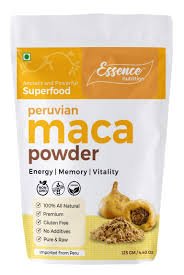Maca powder, derived from the root of the maca plant, has gained popularity as a superfood due to its potential health benefits. It is often used to enhance energy, balance hormones, and support overall well-being. However, with various types of maca powder available on the market, choosing the right one can be challenging. In this guide, the process of selecting the most suitable maca powder will be simplified, providing insights into the different types, benefits, and factors to consider when making a purchase.
Understanding Maca Powder Types
The first step in choosing the right maca powder involves understanding the different types available. Maca root comes in three primary colors—yellow, red, and black—each offering unique benefits. It should be noted that the color of the maca root is indicative of the specific nutrients and compounds it contains.
- Yellow Maca: The most commonly available type, yellow maca, is considered a general tonic for overall health. It is often recommended for those new to maca powder due to its mild flavor and balanced nutritional profile.
- Red Maca: Red maca is known for its higher antioxidant content and is often used to support prostate health, bone strength, and hormone balance. It has a sweeter taste compared to yellow maca, making it a popular choice for smoothies and other recipes.
- Black Maca: Black maca is considered the most potent of the three varieties. It is often chosen for enhancing energy, stamina, and memory. Black maca is particularly popular among athletes and those looking to improve their physical performance.
When selecting maca powder, the type should be chosen based on individual health goals and preferences.
Organic vs. Non-Organic Maca
The decision to choose organic or non-organic maca powder is another important consideration. Organic maca is grown without the use of synthetic pesticides or fertilizers, ensuring that the product is free from harmful chemicals. It is also generally considered to have a higher nutrient content due to the natural farming practices used.
Non-organic maca, while typically more affordable, may contain traces of pesticides or other chemicals. Therefore, for those prioritizing health and purity, organic maca powder is recommended. The USDA Organic label or other certified organic labels should be looked for when purchasing.
Gelatinized vs. Raw Maca
Maca powder is available in two forms: raw and gelatinized. The term “gelatinized” does not refer to the presence of gelatin but to a process that involves heating the maca root to remove starch, making it easier to digest.
- Raw Maca: Raw maca powder is made by drying the maca root and grinding it into a fine powder without applying heat. This form is believed to retain the highest levels of nutrients, including enzymes and vitamins. However, raw maca may be more difficult to digest for some people, potentially causing stomach discomfort.
- Gelatinized Maca: Gelatinized maca powder is processed using heat to break down the starches, resulting in a more concentrated product that is easier to digest. Although some nutrients may be lost during the heating process, gelatinized maca is often recommended for those with sensitive digestive systems.
The choice between raw and gelatinized maca powder should be based on digestive tolerance and the desired concentration of nutrients.
Quality and Sourcing
The quality and sourcing of maca powder should also be carefully considered. High-quality maca is typically sourced from the Peruvian Andes, where the plant has been traditionally grown for centuries. The altitude and climate of this region are ideal for producing nutrient-rich maca roots.
When choosing a maca powder, it is important to ensure that the product is sourced from reputable suppliers who adhere to sustainable and ethical farming practices. Transparent labeling and certifications, such as Fair Trade, can indicate that the maca has been sourced responsibly.
Additionally, the processing methods used by the manufacturer should be considered. Cold-processed or freeze-dried maca powders are preferred, as these methods preserve the nutritional integrity of the maca root.
Consideration of Taste and Usage
The taste of maca powder can vary depending on the type and form chosen. Yellow maca is often described as having a nutty or earthy flavor, while red maca is sweeter, and black maca has a slightly bitter taste. These flavor profiles should be considered when deciding how to incorporate maca powder into the diet.
Maca powder can be easily added to smoothies, juices, oatmeal, baked goods, and other recipes. The versatility of maca powder allows it to be used in both sweet and savory dishes. It is important to start with a small amount and gradually increase the dosage to allow the body to adjust to this new supplement.
Potential Side Effects and Precautions
While maca powder is generally considered safe for most people, potential side effects and precautions should be noted. Some individuals may experience digestive discomfort, especially when consuming raw maca powder. Others may notice changes in hormone levels, as maca can influence the endocrine system.
It is recommended to consult with a healthcare provider before adding maca powder to the diet, especially for those with pre-existing health conditions, pregnant or breastfeeding women, and those taking hormone-related medications.
Conclusion
Choosing the right maca powder requires careful consideration of various factors, including the type of maca, whether it is organic or non-organic, raw or gelatinized, the quality and sourcing, and personal taste preferences. By understanding these aspects, a well-informed decision can be made, ensuring that the maca powder chosen will provide the desired health benefits. Regular consumption of maca powder can contribute to overall well-being, but it should be introduced gradually and with attention to the body’s response.










